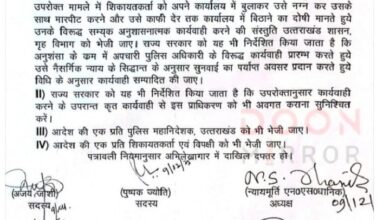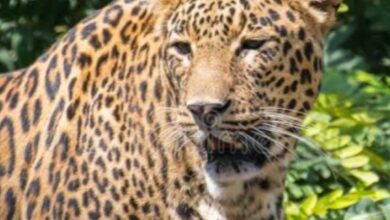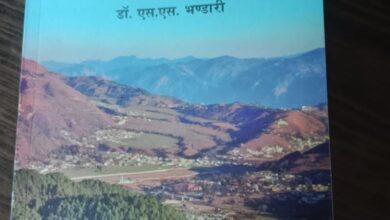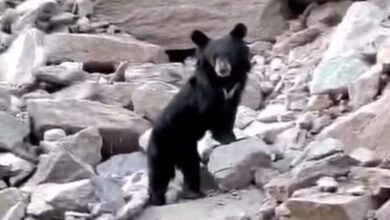Uttarakhandis have to choose between divisive communal agenda or legacy of Chander Singh Garhwali
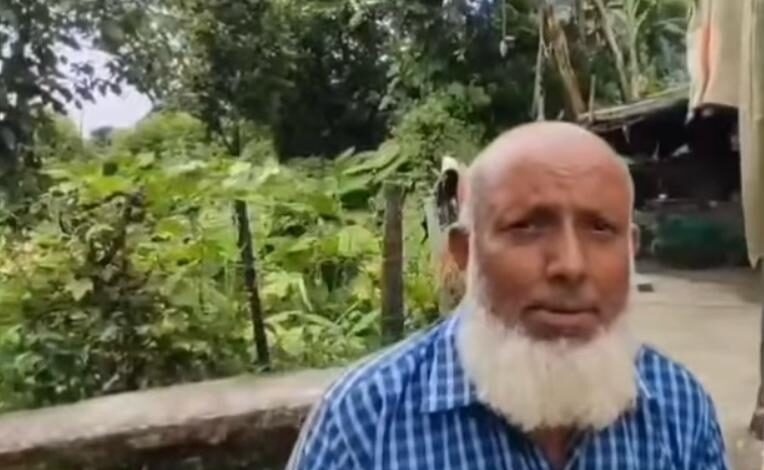
Uttarakhandis have to choose between divisive communal agenda or legacy of Chander Singh Garhwali
By Charu Tewari
A highly provocative and aggressive propaganda is being unleashed for the past many years about the imaginary threat to Uttarakhand hills known as ‘Devbhoomi’ ( the abode of Gods) from the invasion of Muslims. . ‘Fears’ are being expressed that Devbhoomi (the land of Gods) is going to be ‘polluted’ and a concerted campaign to malign and oust the minuscule minority community with the backing of the rightwing bodies has been going on in full swing with the sole ulterior motive of communal polarisation and for political gains. An entire social media campaign with sermons to ‘protect’ the religion and society of the state is been going on impunity for the past several years which reached its’ peak ahead of last assembly polls in 2022. The ruling party benefitted from it and since then, after testing it on the ground has been portraying and making the hill people believe that the entire Uttarakhand mountains are going to be in the control of Muslims. There has been a slender campaign for the past several years that there has been demographic change in the hills and the population of Muslims has increased manifold and they are spoiling the social and cultural ambience of the ‘Devbhoomi’.
Every effort, any ploy, every anti-social activity or petty crime is being exploited and given a communal colour even elections and inter religion marriages are being used to spread hate in the serene mountains of Uttarakhand which despite home to the revered Hindu religious places had been an epitome of communal harmony and coexistence for centuries.
Since panchayat and municipal elections are again due in the state, one is reminded of last panchayat elections when a poster was circulated on social media in the Bhatraujkhan area of Bhikiyasain development block of Almora district. The poster was about a woman contesting Panchayat elections for the post of Gram Pradhan. But what was surprising and condemnable was the storm caused in the political and social circles of Kumoan hills is the name of the woman candidate. Yes, her name was Farah and her husband’s name is Usman. A vicious campaign was launched and questions were raised on ‘Muslims’ becoming Gram Pradhan in the mountains.
The candidature of Farah, a Muslim had given an opportunity to such elements to spread their imaginary threats and fears amongst the majority community. The BJP and people with similar ideology, basically want to suppress the voices of opposition against their anti-mountain policies. The name of the village from where Farh belongs is Danpo. Bhatraujkhan also comes within the Danpo Gram Sabha of Bhikiyasain development block of Almora district. Muslims had been living in Danpo village for centuries. Like many other villages of Uttarakhand, these Muslims have been part and parcel of the local culture and society for centuries. Our friend and advocate Chandrashekhar Kargeti, associated with social concerns, and a resident of this village informed that Muslim families have been settled in their Gram Sabha since past several generations and have uniquely assimilated with the culture and language of the region. These Muslims are involved in the joys and sorrows of the entire villages. There was a family of Jabbar Bhai who played musical instruments for entertainment in the marriages and other joyous occasions . Farah is the daughter-in-law of these Muslims.
In the context of Danpo village incident, there is a need to understand the communal agenda being spread in the entire country and particularly in Uttarakhand in a planned manner to make enemies within the societies that had been living together peacefully and harmoniously for the past many centuries. It takes centuries for the various groups to develop brotherhood and camaraderie but it takes unfounded rumors to destroy it in a wink.
There have been attempts by vested interests to tell people who had been living together for centuries that their neighbors are very ‘dangerous’ and ‘anti-national’. A large number of Muslims settled in Danpo village are permanent residents since time immemorial. They have been part of the cultural heritage of this region as there will be no socio-cultural event in which they are not active participants.These Muslims have been part of the local society whether participating in the festivals from ‘Ramleela’ and ‘Holi’ to auspicious festivities or times of sorrow. They were never seen by local Hundu community as Muslims but considered as their own. To them, there was no difference between Holi, Diwali and Eid. They have been celebrating ‘Jagar’ in the same way as Hindus do. But alas, the politics of today is telling them that they are different and Muslims are ‘enemies’ to be hated.
In the context of Danpo village and Farah, it has become very important to discuss about the Muslims of Uttarakhand. An impression is being created that Muslims have invaded Uttarakhand hills and all kinds of falsehoods about them sweeping the hills are being spreads with impunity since 2021. It was not the first time that a Muslim contested the Panchayat elections in Uttarakhand. Earlier also, about 11 Muslims have become Panchayat members in the state. Sixty three villages in the mountainous districts of Uttarakhand are either Muslim-dominated or have a large number of Muslims living there. These Muslims have not come to live in the mountains recently but had been living here for centuries. Since the days of feudal kings, Muslims had been living not only in the cities of the hills but also in the mountain villages. Interestingly, not only Muslims but Sikhs and Christians had also been part of the Uttarakhand rural scenario . In the Pauri Garhwal district , there are more than a dozen Sikh villages. Among which Gular, Mandoli, Kuchyari, Adani and Barath are important. Famous freedom fighter Shishram Pokhriyal and our friend and Uttarakhand state agitator late Dev Singh Negi were from the Sikh community. We know them as ‘Sikh Negi’. They did not wear turbans, but they do have ‘Gurudwaras’ and had old relations with Garhwali ‘Kshatriyas’ ( Rajputs). Many of them have been representatives of Panchayats. Two Englishmen have also been village heads here. Prominent among them is Peter Frederick who was the village head of June State of Bhimtal. Therefore, the dangerous intentions of communal politics should be understood.
As far as the settlement of Muslims is concerned, an entire Nyaya Panchayat of Tehri district is of Muslim majority villages. When I talk to my friend Bilal, who lives in this area, he greets me with Pranam and Jai Chandrabadni. In the Anjalisain area of Block Jakhnidhar, there are Muslim majority villages like Moli, Andharethi (Kafalna), Gaudhans, Sunali, Bhantwadi, Nirali, Bosta, Chunarkoti, Pahalgaon, Nigwali, Mathmingwali. They were settled here since the time of the feudal kings and are permanent residents deeply assimilated in the local society and culture.
From time to time, Muslim representatives had been elected in the Panchayat elections from here. Rehana Begum was the Gram Pradhan of Basta village. Last time this seat was reserved for Scheduled Castes. Basir Ahmed was elected Gram Pradhan from Ningwali village. This time also four Muslim candidates are in the election fray. Muslims had settled in Pauri district’s Kandakhal, Pallgaon, Ramgaon, Judda Bungdhar, Simli, Masoli etc. since the beginning of the 20th century. Most of them were Gujars. They used to graze buffaloes in the Malini river and also did agriculture and animal husbandry in the villages when they got the opportunity. There are a large number of Muslim ‘Mirasis’ also in Garhwal who are perfectly assimilated in the cultural heritage of this place. In Garhwal, the Jagar of ‘Said’ or ‘Syed’ is common. Keshav Anuragi, a connoisseur of folk, used to sing ‘Saidwali’ with great devotion – ‘Salam Walekum, Sallam Walekum/Tyara Miya Ratnagaji, Sallam Walekum/Teri O Bibi Fatima, Sallam Walekum/Tyara Begaud Gazina, Sallam Walekum/Teri O Kalma Quran, Sallam Walekum/Salam Walekum, Sallam Walekum.’
Muslims have been living in dozens of villages in Pithoragarh and Champawat districts for centuries. There has been a large settlement of Muslims in Dewalthal (Usel), Koli Bhek of Lohaghat, Manihar Goth of Champawat and Jauljivi. There is a mosque built in Manihar Goth. Naseem Ahmed of Bhek village, who is a teacher in Tanakpur nowadays during his students days contested the student union elections and he is still among the most popular citizens of the town here. There has been a very old settlement of Muslims in Sani Udyar of Bageshwar district. In Dewalthal (Usel) a village of Brahmins, there is a large settlement of Muslims. Our colleague and senio journalist Jahangir Raju tells that his ancestors have had a very deep relationship with the social and cultural fabric of this place. Raju tells that his ancestor Sheikh Rahmatullah was the first lightman of the Ramlila started 150 years ago. In those days, Ramlila was performed using gas. The entire arrangement was the responsibility of Sheikh Rahmatullah. Even today, in the village of Usel, no puja is performed in the temple without the offerings of the Muslims. There is a tradition in Dewalthal that when Holi comes to Dewalthal from Usel, it will first go to the house of a Muslim. Raju says that even today, this Holi comes to his house first. He said that his grandfather was a very good ‘Vaidya’ and many of his books on ‘Ayurveda’ are still with the family. He used to treat people in villages without taking any money. Dewalthal falls in Barabisi Patti and is a centre of many villages. A large number of people from this area served in the India army since past century and when they used to come home on leave, they used to get late in returning home. Raju’s grandmother had made her house a ‘Dharamshala’ at Dewalthal and most of the soldiers’ of yesteryears stayed with them. Her grandmother used to feed them also and when soldiers returned she used to give them fruits from her garden. She used to send them off like one of her own relatives despite not knowing them. Raju tells that his father’s job was to sell bangles and chareu but none in the entire area called his father by his name. They used to respectfully called by his relation- Dajyu, Kaka, Chacha, Tau etc.
A very old Muslim family lives in Dharamghar of Pithoragarh. A large number of Muslims have been living in villages like Bhandargaon, Bagwali Pokhar, Kunwali, Majkhali, Riyuni, Someshwar, Chanoda, Bachkhaniya (Chaikhutia), Dwarasoun etc. of Almora for centuries. If you are going to Dehradun, you will find a hotel near Muzaffarnagar – Cheetal. This hotel belongs to a Muslim family of Riyuni. This family has contributed a lot to the cultural and social life here. A large number of Muslims have been living in Bhandargaon and Bagwali Pokhar market of Gagas Valley in my area for centuries. The families of Haider and Hamid have been a part of the culture here. Haider ji’s children Anwar and Amina used to study with us. Anwar later joined the army. Now he has retired and has come home. Names like Hamid, Uhaf, Shakur Baksh etc. still come to my mind. There was a boy of this family, Hanif Mohammad and we used to call him Hannu. He earned a lot of fame in volleyball. He played at the national level. He got recruited in the railways through sports quota. There is a Muslim village in Kunwali of our region – Roula Kharak. Muslims have been living in this village since a long time. Muslims have been living in the Nandprayag area of Chamoli district since long. These Muslims also took the responsibility of arranging for the pilgrims during the pilgrimage season. The Muslims here also built a dharamshala for Hindu pilgrims. I don’t know how much truth there is in this, but it is said that Badruddin of this family wrote the Aarti of Badrinath.
The kind of rumours being spread are a conspiracy to destroy our centuries-old traditions and mutual relations. It is very important to understand that Muslims have played an important role in nourishing our cultural heritage. There are many Ramlilas in the hills which we cannot even imagine without Muslims. Muslims have been playing the roles of Ram, Laxman, Sita etc. in the Ramlilas of Almora for decades. Many of our colleagues, including the famous theatre artist Zahoor Alam, Dr. Ahsan Baksh, have not only kept our folk genres Ramlila and Holi intact, but have also launched a campaign to take it to a wider platform. Historian Dr. Anwar Ansari has written- ‘This fact is also important that even after accepting Islam, the local Muslims could not separate themselves from the local traditions. Just as the Momin Boras of Maharashtra consider the land division of Yagyavalkya Smriti as the basis or travel to ‘Padharpur’ like ‘Mecca’, in the same way the converted Uttarakhandi Muslims continue to worship all the common gods and goddesses and make vows like their neighbouring Hindus. The mountain people seek refuge in gods and goddesses. Until the First World War, the priests of the rural Muslims of Garhwal used to be Brahmins only.
There is a need to be cautious about the acts that some hateful people are doing by calling Uttarakhand ‘Devbhoomi’ and wearing the garb of ‘Hindutva’. They have neither any religion nor any sensibilities of their own. The so-called ‘patriots’ and ‘contractors of religion’ are involved in Ankita murder case, murder of Dalit youth Jagdish, snatching grass from women in Helang, recruitment scam, giving appointments to their own people in the assembly or relaxing the land laws for loot of Uttarakhand’s land. No Muslim is involved in these acts but they were being blamed for all the ills of the Uttarakhand.
The kind of statements that the state head Pushkar Singh Dhami regarding bringing in strict land laws shows the shamelessness of the BJP governments which relaxed laws to outright sell the hills in 2018 and further relaxed in 2022. Now as a diversionary tactics is raising the danger of ‘land jihad’ in Uttarakhand, earlier he had raised the issue of ‘Mazar Jehad’ and destroyed more than three hundred structures on encroached government land. Has his government identified any Hindu religious place on encroached government land.
Interestingly, two years ago, a ruckus was also created on the arranged marriage between the daughter of a BJP leader from Pauri Garhwal with a Muslim boy. Well, whatever be the crooked politics behind the Hindu-Muslim agenda, but marriages between Hindu-Muslim people have been taking place in Uttarakhand for centuries. There are some such marriages which show the mirror to these so-called “cultural contractors”. One famous couple among them was Lokdharmi Mohan Upreti and Naima Khan. These two had a love marriage in those days when it was unthinkable in the traditional high class Brahmins of Almora. History is witness to the fact that the Mohan-Naima couple devoted their entire life for the folk heritage of Uttarakhand. They played a significant role in bringing the representative songs of Uttarakhand like ‘Bedu Pako Baramasa…’, ‘Pare Bhide Ki Basanti Chhori…’, ‘Sur-Sura Maruli Basige…’, ‘O Laali O Laali Haunsia…’ to the wider platform. By making dramatic adaptations of Uttarakhand’s folk tales ‘Rajula Malushahi’, ‘Ajuaa Bafoul’, ‘Gori Dhana’, these two made a historic contribution to the folk genres. They did a lot of work for Ramlilas. They sang “Chaapaiyas” in Ramlilas. They sang separation songs in the drama ‘Gaura’. It is no less interesting to know that Naima ji’s family was an elite Muslim family of Almora. Her grandfather Niaz Muhammad was a commissioner in the Municipal Board. A locality in Almora is named Niazganj after his name. Naima ji’s father Shabbir Muhammad Khan had married a Christian woman.
Even if we leave aside the cities, Muslims live in about 150 villages in Uttarakhand. They have played an important role in enhancing our culture, language and folklore. They have even assimilated our cultural symbols and folk beliefs. That is why in Garhwal, ‘Said ki Jagar’ is sung as ‘Saidwali’. Folk connoisseur Keshav Anurag made ‘Saidwali’ immortal on Akashvani as Garhwali started worshipping “Peer Baba’ and all this was possible through cultural assimilation. They had so much faith in ‘peer baba’ that even after migrating from hills to the plains of Dehradun and Rishikesh they built ‘mazars’ of ‘Syeds” in their fields and houses. A concerted campaign is also underway by a Hindatva zealot to destroy such structures.
Even today, there are many talented Muslims like our senior famous theatre artist Zahoor Alam of Nainital, Pithoragarh resident and script writer in Mumbai Dr. Baksh, folk artist Shamshad Pithoragarhi, painter Salim, who have contributed to the richness of the Holi, Ramleela, theatre and folk traditions and on whom ‘Devbhoomi’ is proud.
Well, the hero of the Peshawar rebellion Veer Chandra Singh Garhwali would not have imagined that the people of ‘Devbhoomi’, who once lived in cities like Lahore, Quetta, Rawalpindi, Peshawar and developed their cultural-political consciousness and created milestones in history, would become so crazy about religion and caste. Chander Singh Garhwali not only taught the people of Uttarakhand but to the entire world to stand with self-respect by refusing to fire on unarmed ‘Pathans’ showing the world that humanity is greater than religion. After independence, when Frontier Gandhi Abdul Ghaffar Khan came to India, Nehru ji told him- ‘We are glad that you came to meet us.’ Ghaffar Khan said- ‘I have come to meet Chandra Singh Garhwali, not you.’ Veer Chandra Singh Garhwali’s legacy is of love, not hatred. Therefore, our legacy should be understood properly.
We need to be cautious about the kind of misconceptions that have been spread about the Muslim community of Uttarakhand or the imaginary fear that is being created. We are not in danger from any Muslim or outsider. We are in danger from our own people who are trying to swallow the mountains and are busy in selling the mountains while sitting in power. We are in danger from those who are robbing our lands by bringing land laws for the capitalists. We are in danger from those who are closing our government schools. We are in danger from those who are giving our hospitals on PPP mode. We are in danger from those who are building destructive dams like Pancheshwar. We are in danger from those who are plotting against Gairsain as the capital. We are in danger from those who are delivering liquor through mobile vehicles. We are in danger from those who are opening liquor factories. We are in danger from those who are getting the companies closed in SIDCUL. We are in danger from those who want to destroy the consciousness of an entire generation. They want to swallow our centuries old traditions, beliefs, mutual brotherhood, harmony and cooperative society. We are in danger from those who want to destroy our cultural consciousness with their communal agenda with sole aim of grabbing political power by hook or crook. The people of Uttarakhand need to choose between a divisive philosophy or the brave legacy of Chander Singh Garhwali.
(Charu Tewari is a senior journalist from Uttarakhand based in New Delhi)
( Originally published in Hindi)


